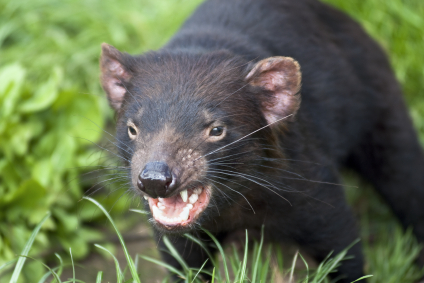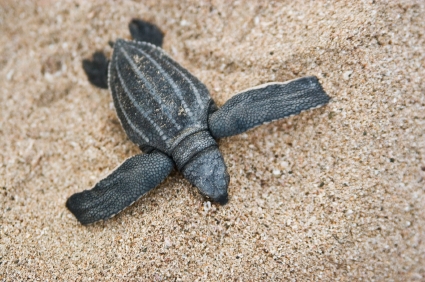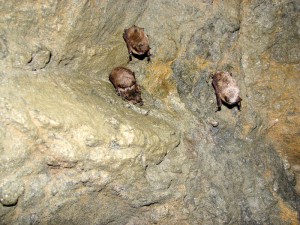 If you are of a certain age, the name “Tasmanian Devil” most likely conjures up an image of a ferocious brown hairy cartoon character that traveled in the center of a tornado of chaos. Sometimes, as in this case, the truth is much less strange than the fiction. The real Tasmanian Devils (Sarcphilus harrisii) are relatively small, somewhat cuddly looking, marsupials found only on the island of… you guessed it, Tasmania. Despite their diminutive size, they are the largest living carnivorous marsupial. Unfortunately, these terrier-sized animals are also in danger of becoming extinct, largely as a result of a deadly, infectious transmissible cancer called Devil Facial Tumor Disease (DFTD). Continue reading “The Devil is in the Details: Genetic Diversity and the Endangered Tasmanian Devil”
If you are of a certain age, the name “Tasmanian Devil” most likely conjures up an image of a ferocious brown hairy cartoon character that traveled in the center of a tornado of chaos. Sometimes, as in this case, the truth is much less strange than the fiction. The real Tasmanian Devils (Sarcphilus harrisii) are relatively small, somewhat cuddly looking, marsupials found only on the island of… you guessed it, Tasmania. Despite their diminutive size, they are the largest living carnivorous marsupial. Unfortunately, these terrier-sized animals are also in danger of becoming extinct, largely as a result of a deadly, infectious transmissible cancer called Devil Facial Tumor Disease (DFTD). Continue reading “The Devil is in the Details: Genetic Diversity and the Endangered Tasmanian Devil”
endangered species
Satellites and Sea Turtles: Can We Save the Last Member of the Genus Dermochelys?
 Let me start out by saying: I love sea turtles. I can’t explain why, but they fascinate me. I have sweatshirts, bags and artwork with sea turtles on them. I even make jewelry with sea turtle themes. Ask anyone who knows me; I have a thing for sea turtles. So when I came across the article “Tracking leatherback turtles from the world’s largest rookery: Assessing threats across the South Atlantic” in the Proceedings of the Royal Society B (1), all thoughts of writing about anything else were readily dismissed. How could I NOT write about leatherback sea turtles? Continue reading “Satellites and Sea Turtles: Can We Save the Last Member of the Genus Dermochelys?”
Let me start out by saying: I love sea turtles. I can’t explain why, but they fascinate me. I have sweatshirts, bags and artwork with sea turtles on them. I even make jewelry with sea turtle themes. Ask anyone who knows me; I have a thing for sea turtles. So when I came across the article “Tracking leatherback turtles from the world’s largest rookery: Assessing threats across the South Atlantic” in the Proceedings of the Royal Society B (1), all thoughts of writing about anything else were readily dismissed. How could I NOT write about leatherback sea turtles? Continue reading “Satellites and Sea Turtles: Can We Save the Last Member of the Genus Dermochelys?”
The Latest On: When Five Hundred Tigers Are Not Enough
It is sad but true that the latest news has not been promising for wild tiger populations. In September, an article published in PLoS Biology (1) estimated that the best hope of saving the wild tiger population would be to shift focus to source sites, which are “…at spatially well-defined priority sites, supported by proven best practices of law enforcement, wildlife management, and scientific monitoring.” The authors estimate the cost to save these sites at $82 million (U.S). At the time of publication, $47 million had been committed by governments and other groups. It isn’t difficult math to figure out there is a deficit.
Continue reading “The Latest On: When Five Hundred Tigers Are Not Enough”When a Cold, Wet, White Nose Isn’t a Good Thing
On February 16, 2006, a recreational caver exploring Howes Cave in Albany, New York, photographed a bat with an unusual white growth on its muzzle. In the few years since that picture was snapped, hundreds of thousands of bats in North America have died from White-Nose Syndrome (WNS; 1,2).
The disease affects hibernating populations of bats, and has been found in the northeastern and eastern United States, as far south as Tennessee, as well as in the Canadian provinces of Quebec and Ontario (2).
Some suffering bats are emaciated with little or no body fat and have a characteristic white fungal growth on their wing membranes, ears and muzzles, hence the name “White-Nose Syndrome.” Instead of hibernating all winter, these bats can be seen active in the snow, when there is virtually no food available for them (1,2).
The white fungal growth observed on the bats is the result of infection with a previously undescribed cold-loving fungus,
Continue reading “When a Cold, Wet, White Nose Isn’t a Good Thing”
